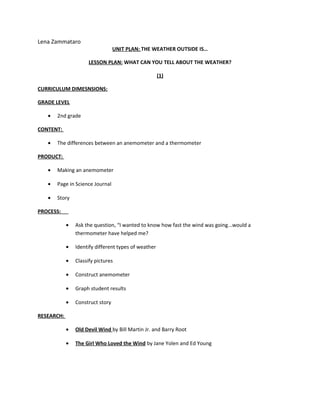
Weather Tools Lesson
- 1. Lena Zammataro UNIT PLAN: THE WEATHER OUTSIDE IS… LESSON PLAN: WHAT CAN YOU TELL ABOUT THE WEATHER? (1) CURRICULUM DIMESNSIONS: GRADE LEVEL · 2nd grade CONTENT: · The differences between an anemometer and a thermometer PRODUCT: · Making an anemometer · Page in Science Journal · Story PROCESS: · Ask the question, “I wanted to know how fast the wind was going...would a thermometer have helped me? · Identify different types of weather · Classify pictures · Construct anemometer · Graph student results · Construct story RESEARCH: · Old Devil Wind by Bill Martin Jr. and Barry Root · The Girl Who Loved the Wind by Jane Yolen and Ed Young
- 2. NEW JERSEY CORE CURRCICULUM CONTENT STANDARDS: STANDARD 3.2 (WRITING) (A) 1. Generate ideas for writing: hearing stories, recalling experiences, brainstorming, and drawing. (C ) 1. Use correct end point punctuation. 2. Apply basic rules of capitalization. 6. Write legibly to meet district standards. STANDARD 3.3 (SPEAKING) (A) 2. Begin to stay focused on a topic of discussion. 3. Offer personal opinions related to topics of discussion. 4. Wait their turn to speak. STANDARD 5.8 (EARTH SCIENCE) (A) 3. Describe current weather conditions and recognize how those conditions affect our daily lives. (B) 4. Describe daily and seasonal changes and patterns in the weather. STANDARD 9.2 (CONSUMER, FAMILY, & LIFE SKILLS) (C) 5. Work cooperatively with others to accomplish a task. LEARNING OBJECTIVE(S): The students will be able to identify different types of weather The students will be able to construct an anemometer
- 3. The students will be able to infer which tool would be used in a given situation INSTRUCTIONAL ACTIVITES THE TEACHER WILL: MOTIVATE BY… · Telling a story about the weather outside on a previous day. - “It was a beautiful fall night so I decided to go outside for a walk. I almost got to the park near school when … WHOOOSH! A big gust of wind hit me! It was blowing so fast that it almost knocked me over! After the wind stopped, I began thinking. I was curious to know how fast it was going!” - “Would a thermometer have helped me?” (hold up thermometer) INTRODUCE/REVIEW/EXTEND CONTENT BY… · The teacher will have the students brainstorm about the different types of weather. The students will have several books present for assistance if they are having difficulty. The students will then come to the board to write the different types of weather. The teacher will then review with the class each of the responses the students had written. INTRODUCE/REVIEW/EXTEND PROCESS BY… · The students will correctly classify and explain what measurement tool would be the best to use in a series of pictures. The students will work with a partner using the activity cards. The teacher will review the classifications the students have chosen. The teacher will then ask the students to create an anemometer. The students will be asked to make predictions in their science journals about what will happen when the anemometer is taken outside. INTRODUCE/REVIEW/EXTEND PRODUCT BY… · The students will test their anemometers outside. Students will then be asked to report their individual results to the class. A graph will be constructed based on the results. The students will then be asked to construct a story in which an anemometer would be most appropriately used. Examples will be provided for guidance and inspiration. The pictures from the activity cards and the weather books provided will also be a reference. EXPLAIN/LIST ASSESSMENT CRITERIA BY… (all students)
- 4. · Participation during the lesson through brainstorming activities · All students will correctly identifying different types of weather · Correctly classifying the pictures based on the weather conditions presented · Ability to apply what they have learned about anemometers (definition/wind direction) to their stories CLOSE THE LESSON BY… The teacher will ask the students to copy down the definitions for anemometer and thermometer to their science journals. Students will also be asked to complete a three question review sheet that will serve as a ticket out. MATERIALS: · Smartboard for activity card enhancement · Activity cards · Science journals · Ticket out sheets · Thermometer · Tape · 2 cups (for every student) · 1 unsharpened pencil (for every student) · 1 pushpin (for every student) · 1 bead (for every student) · 1 sheet of lined paper (for every student) DIFFERENTIATION: · Visual: o Activity cards o Use of Smartboard to enhance images o Use of pictures from reference books
- 5. · Auditory: o Directions and explanations will be read and explained verbally. · Naturalist: o The weather and temperature will be explored · More-abled learner: o Ask to draw a picture to accompany their story · Less-abled learner: o Physically demonstrate the effects of an anemometer EXTENSION ACTIVITIES: · Have students investigate if they have a thermometer or anemometer located in their homes.
- 6. · Auditory: o Directions and explanations will be read and explained verbally. · Naturalist: o The weather and temperature will be explored · More-abled learner: o Ask to draw a picture to accompany their story · Less-abled learner: o Physically demonstrate the effects of an anemometer EXTENSION ACTIVITIES: · Have students investigate if they have a thermometer or anemometer located in their homes.